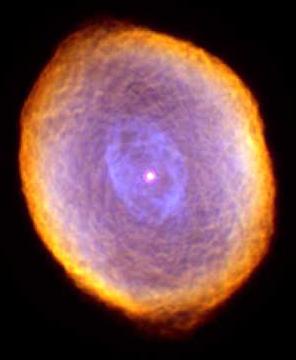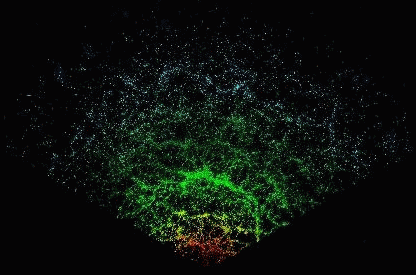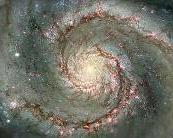
|
Quasars are the most massive objects known in the universe, by far.
They act, therefore, as an effective tracer of the mass in the
universe, making a large-scale quasar catalog useful for answering a
wide range of astronomical and astrophysical questions. The largest
existing quasar catalog consisted of about 30k quasars. Using a
highly accurate nonparametric Bayes classifier and our
new algorithm
allowing it to scale to training sets of up 500k points, we obtained a
very clean (high efficiency, high completeness) catalog of 100k
quasars, with 500k easily in reach. Our goal is to identify all of
the expected 1 million or so z<3 quasars in the universe. (Richards,
Nichol, Gray, et al. Efficient Photometric
Selection of Quasars from the Sloan Digital Sky Survey: 100,000
z<3 Quasars from Data Release One [pdf], [ps] Astrophysical Journal Supplement 2004.)
|
|
Galaxy Morphologies and Clusters
| |
Using a variety of clustering methods as well as supervised methods,
we obtained statistical characterizations of galaxy morphology classes
and compared them to the subjectively-defined Hubble sequence. (de
Carvalho et al. Clustering Analysis Algorithms and Their
Applications to Digital POSS-II Catalogs, AAS 1995.)
The locations of so-called galaxy clusters have traditionally been
subjectively defined. We used Bayesian mixture models to obtain a large-scale
cluster catalog statistically. (de Carvalho et al. Towards an
Objectively Defined Catalog of Galaxy Clusters from the Digitized
POSS-II, Wide-Field Spectroscopy 1997.)
A survey of these and other analyses we performed was in (Djorgovsky et al.
Data-Mining a Large Digital Sky Survey: From the Challenges
to the Scientific Results, SPIE 1997.)
|
|
Computational Astrophysics,
Cosmology, and Astronomy
| |
|
Modern biology is certainly exciting,
but it is not the only dramatic thing going on in science. Modern
astrophysics is today's hotspot of physics, and one of science in
general. New instruments, and the datasets they produce, keep making
this area more exciting. I have been working on astronomical data
analysis since 1993, in the days of the POSS-II survey. I'm an
official external member of the SDSS
Collaboration. Some of my fine current astrophysicist
collaborators: Bob
Nichol, Andy Connolly, Chris Miller, Gordon Richards, Robert
Brunner, Michael Balogh, David Wake, Gauri Kulkarni.
|
Dark energy is a theorized phenomenon which opposes the
self-attraction of matter and causes the expansion of the universe to
accelerate. It is not simply of astrophysical interest -- if it
exists it implies changes to fundamental physics. To learn more about
dark energy and the current state of affairs in physics, here's a
layman's overview
and a more detailed
overview by Peebles
(the guy who wrote two of the bibles of cosmology).
Our n-point algorithm was used by our collaborators
for large-scale exploratory calculations required to spatially
cross-correlate the WMAP data with the Sloan Digital Sky Survey. This
work resulted in major new evidence for dark energy and was recognized
as part of the Science Top Scientific
Breakthrough of 2003. (Scranton, Connolly, Nichol, et al. Physical Evidence for
Dark Energy, submitted to Physical Review Letters 2003.)
|
|
The 3-point correlation function is a key discriminant of cosmological
models which cannot be distinguished (i.e. validated or invalidated)
using the usual 2-point correlation function. Our n-point algorithm is currently being used to
compute the largest-scale third-order spatial statistics of the
universe to date. (Nichol et al. The Three-point Correlation
Function of the Sloan Digital Sky Survey Galaxy Sample, submitted
to Astrophysical Journal Letters 2004.)
|

|

 Basic understanding of galaxies can be pursued by studying the
relation between the environment of galaxies and their observed
physical properties using recent large datasets such as the SDSS. Our
n-point algorithm enabled the calculations
behind the spatial statistics of active galactic nuclei in (Wake et
al. The Clustering of AGN in the Sloan
Digital Sky Survey [pdf], [ps]
Astrophysical Journal Letters 2004).
Basic understanding of galaxies can be pursued by studying the
relation between the environment of galaxies and their observed
physical properties using recent large datasets such as the SDSS. Our
n-point algorithm enabled the calculations
behind the spatial statistics of active galactic nuclei in (Wake et
al. The Clustering of AGN in the Sloan
Digital Sky Survey [pdf], [ps]
Astrophysical Journal Letters 2004).

